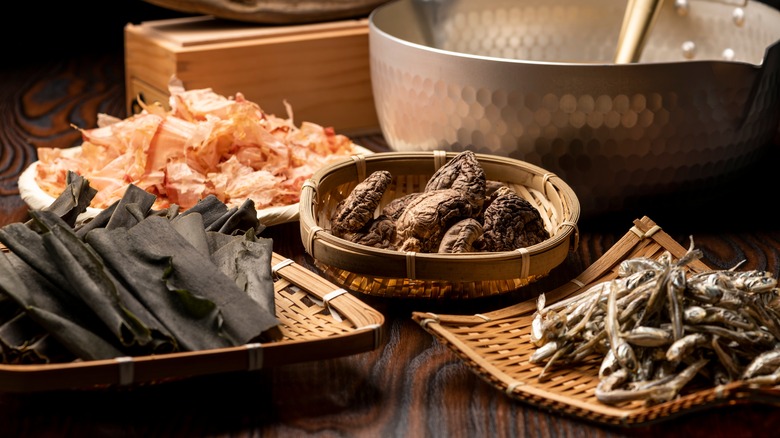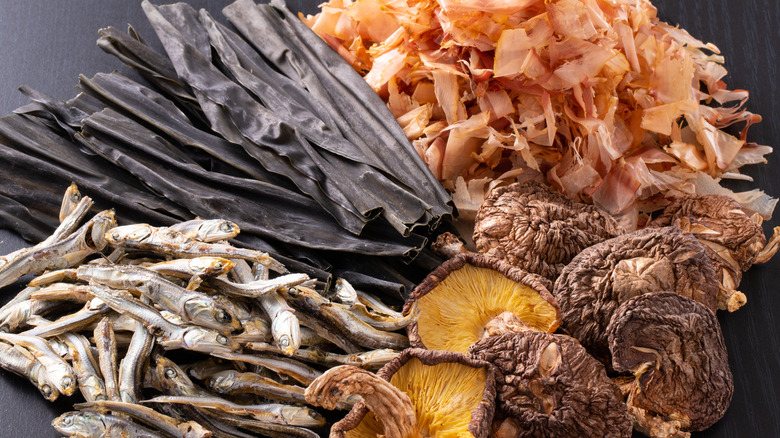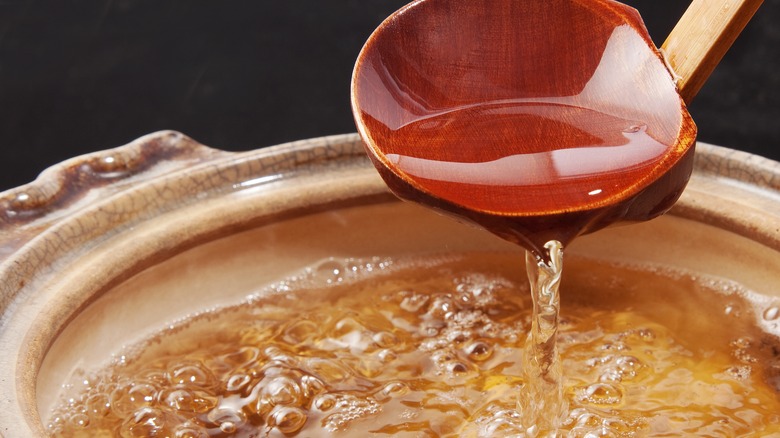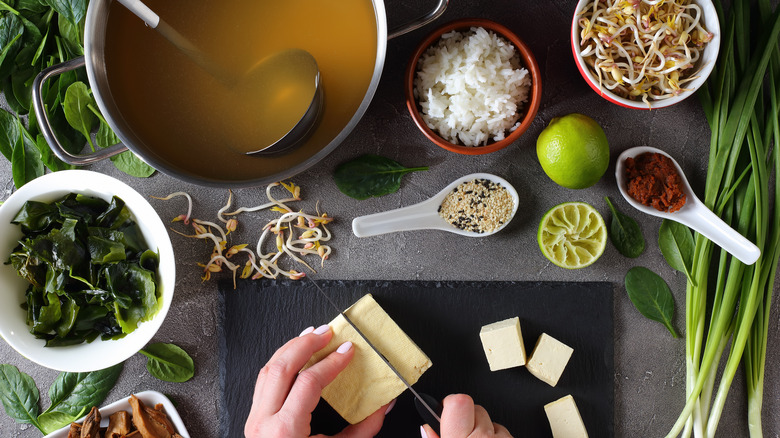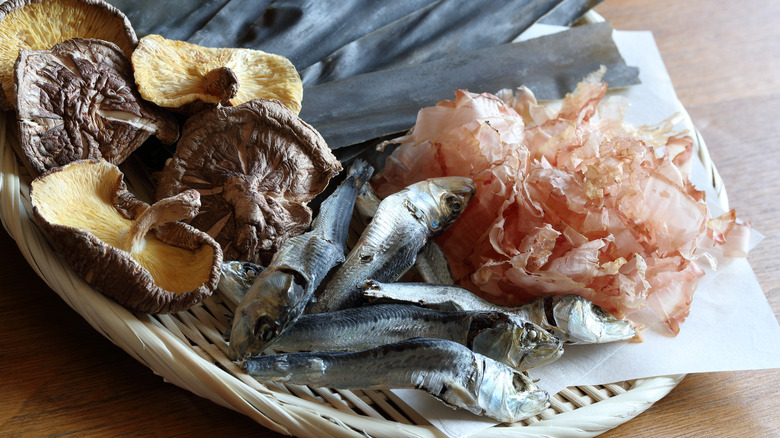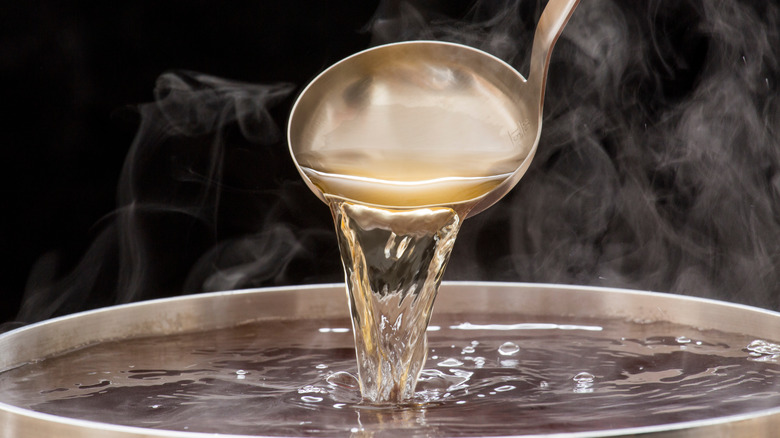What Is Dashi And How Do You Use It?
Japanese cuisine is about more than just the food it produces — it's deeply intertwined with the country's history, climate, culture, and values, explains Japan Educational Travel. Japanese food tends to be very focused on freshness and quality, allowing individual ingredients to shine in a dish, even when cooked in a soup or stock, like the versatile and delicious dashi.
Dashi is a stock that is used in lots of popular Japanese dishes, like chankonabe and miso soup. The oldest confirmed version of dashi dates back to 700 A.D., but modern dashi can be traced back to the middle of the Edo or Tokugawa period, according to Okayama Food. There are a few varying ways to make dashi, but at its core, it's a combination of bonito flakes and kombu, also known as kelp seaweed. It's one of the most important, foundational pieces of Japanese cuisine, so keep reading to learn more about this important element of Japanese cooking.
What is dashi and how is it made?
Dashi is a combination of kombu, or seaweed made from kelp, and katsuobushi, or dried flakes of bonito fish, per Umami Information Center. Dried shiitake mushrooms are also often added, along with niboshi, or small dried fish. There are a few different ways to make the stock, but generally, it involves soaking the kombu then boiling the bonito flakes, shiitake, and niboshi. Once it's seeped long enough for the flavors to permeate, you strain everything out for a clear dashi broth, according to Bon Appétit.
It's estimated that dashi cemented itself as a cooking staple in Japan in the 1800s, and likely in the Kansai region in south Honshū, notes Bite My Bun. Other than that, the origins of dashi itself aren't that definite. While the broth itself is largely the same as it has been since its conception, it's now sold in an instant mix at grocery stores.
What does dashi taste like?
Dashi is known for its rich, umami flavor. As Kikkoman explains, umami is the fifth flavor group, alongside sweet, sour, salty, and bitter. In fact, dashi is the ingredient that led to the definition of umami. Professor Kikunae Ikeda of Tokyo Imperial University was studying the flavor components of dashi and identified the amino acid glutamate in kombu as umami. It's not inherently savory, but foods like cheese, asparagus, mushrooms, most meats and fish, and miso paste are all under the umami umbrella.
Since one of the main ingredients is bonito flakes, it has a somewhat fishy taste — especially if other dried fish are added to the broth as well. Bon Appétit notes that the fishiness of dashi depends on steeping time, so if you steep your bonito and anchovies longer, it will be more potent. The kombu will also imbue an oceanic, seaweed flavor, and shiitake will give the broth an earthy, mushroomy taste.
How to cook with dashi
Dashi is fundamental to Japanese cooking and cuisine, and cannot be replaced by any other stock, Bite My Bun explains. Dashi is commonly added to batters for dishes like takoyaki, which is a dish consisting of octopus or other seafood and a wheat batter, as well as okonomiyaki, a type of savory Japanese pancake.
Dashi is most well known for being the base of miso soup. Kitchn notes that dashi is also eaten on its own, which can help with sore throats or digestive issues. In addition to using it for soups, you can use the flavorful stock to poach various foods, including fish, meat, tofu, and eggs.
It can also be used as a brine or added to vinaigrettes and dipping sauces. Dashi is an excellent source of umami, so consider adding it to dishes that need that extra savory, earthy boost. Chawanmushi, which is a Japanese savory custard, is a prime example of how dashi can take a simple ingredient like eggs to the next level.
Where to buy dashi
Authentic dashi is not something you can readily buy at stores in liquid form like you would boxed vegetable, chicken, or beef broth. Instead, you can either buy the ingredients and make it yourself or, according to Bite My Bun, there is a product called instant dashi or dashi powder that is similar in effect to bouillon. It isn't as flavorful as homemade dashi, but it's a quick and simple alternative. You can find this in the international food aisle at your local grocery store or an Asian market, as well as online, like this one from Amazon.
As for the individual ingredients of dashi, all you need is bonito flakes and kombu. Again, both of these ingredients can be found in grocery stores with world cuisine aisles, specialty Japanese grocery stores, or online. Other add-ons, like dried shiitake mushrooms or anchovies, can be found at the same places.
Nutritional information about dashi
Homemade dashi from seeped and boiled, whole ingredients is very healthy, notes Zero Abundance. The core ingredients — bonito flakes, kombu, and potentially dried shiitake mushrooms and dried anchovies — all inherently have health benefits.
According to Japanese Ingredients, kombu is packed full of minerals, fiber, and as much as six times the calcium content of milk. Bonito flakes have a lot of protein, as well as vitamin B12, iron, and niacin. Shiitake mushrooms are sun-dried, which means they're full of nutritional vitamin D, and anchovies have lots of protein, calcium, and iron, making them great for increasing bone strength and health.
The only potentially unhealthy aspects of dashi are associated with instant dashi or dashi powder, which can contain additives like salt and MSG. Monosodium glutamate has long since been shunned by health food advocates for a list of negative reactions like headaches, increased heart rate, chest pain, and general weakness, referred to as MSG symptom complex, per Mayo Clinic. However, there is no proof or scientific basis that MSG is the cause of these symptoms. If you want to avoid these extra ingredients, Just One Cookbook recommends a few additive-free dashi powders. Regardless of how you make your dashi, you will notice the extra flavor boost in your dishes.
